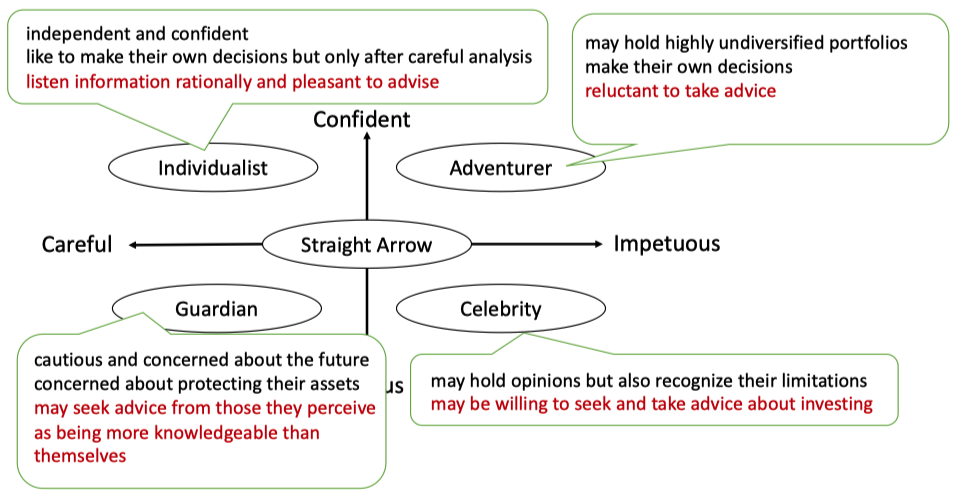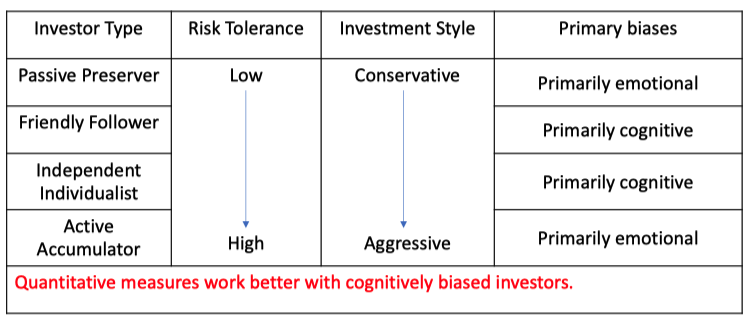Behavioural Finance
Cognitive Error 可以被correct
Based on Faulty cognitive reasoning
Stem from basic statistical, information or memory error
Better education and advice can correct for the cognitive error
Emotional Bias 只能适应它
based on feelings or emotions
stem from impulse or intuition
"Adapt to it"
Cognitive Error
Belief Perseverance: RICCH
Information Processing: FAMA
Belief Perseverance
Representativeness Bias: overweight new info, overweights small sample that is less representative
Base-rate neglect; Sample-size neglect
Illusion of Control: people tend to believe that they can control outcomes, but in fact they can not.
Believe they can control outcomes / Overstate their influence
Overconfidence in trading, fail to adequately diversify
Conservatism Bias: Slowly update to new info, overweight past info
Maintain or slowly update views
holding securities too long
Confirmation Bias (Selection Bias): notice what support their beliefs, ignore what contradict their beliefs 选择看支持他们观点的,忽略反对他们观点的
look for positive info, ignore negative info
Under diversified / Over-concentrated
Hindsight Bias (I knew it all along): see past events as having been predicted 觉得自己预测到了未来,但是实际中没有
overestimate the degree they predicted an outcome
unfairly assess performance and risks
Information Processing
Framing Bias: people answer questions based on how they are asked (make decision based on description)
choose suboptimal investments
forcus on short-term price fluctuation and result in excessive trading
misidentify risks tolerances
Anchoring and Adjustment Bias: oversight the anchor / overweight the default information
stick too closely to the original estimate
Mental Accounting: treat one sum of money differently, 把来源不同的钱,在自己脑子里划分不同意义。但实际上都是钱
group assets into non-fungible (non-interchangeable) mental accounts
neglect opportunities to reduce risk
chase income stream
Availability Bias: based on how easily the outcome comes to mind, to make a decision
make decision based on advertising
limited investment opportunity set and under-diversity
Source 产生availability bias 的原因: retrievability, categorisation, resonance, narrow range of experience
Emotional Bias
LOSSER
Loss Aversion Bias: realise gains early and delay recognising losses
house money effects: engage in increasingly risky gambles with previous winning
disposition effect: hold losers too long and sell winners too quickly
Limited upside potential
trade excessively and hold riskier portfolio 因为好的都卖了,留着的都是垃圾
Initialised by Kahnesman and Tversky (1979) about prospect theory
Overconfidence Bias: Unwarranted faith in their abilities
underestimate risks
Trade Excessively
Hold poorly diversified portfolio
experience lower return than the peers in the market
Illusion of Knowledge bias / Self-attribution bias
Self-Control Bias: deviate from their long term goals to short-term goals 由于不够自律而追求短期目标,而不是长期 (have a strong desire to consume today)
save inefficiently for the future
accept too much risk to generate higher return
cauaw asset allocation imbalanced
Status Quo Bias: People do nothing instead of making changes 不动,不改变。观念很陈旧,不愿意更新
unknowingly maintain portfolios that are inappropriate for their circumstances
fail to explore other opportunities
Endowment Bias: value an asset more when they hold rights to it 对于已有的东西,有感情的东西,看的更重,不愿意卖
Fail to sell off certain assets or replace them
continue to hold classes that are familiar
maintain an inappropriate asset allocation
Regret-Aversion Bias: Avoid making decisions out of fear that turns out poorly 害怕可能会让人后悔的决定。害怕后悔
Error of commission 害怕做错
Error of Omission 害怕错过
Too Conservative
Engage in herding behaviour
Behavioural Finance & Investment Process
Classification of Investors into Types
Barnewall Two-way Model
Passive Investor: accumulate wealth passively
Lower risk tolerance
the small the economic source, the more passive the investor is
Active Investors: actively involved in wealth creation
high RT
prefer to control own investments
if loss of control, RT reduce quickly
Bilard, Biehl, and Kaiser Five-way Model
最下面 是 Anxious

Pompian Model (Four-way Model)

The more emotional bias a person is, tell them more emotional things, "big picture", not statistical data.
For cognitive error exposed investors, tell them reasons
Limitations of Classifying investors into BITs
Individuals may simultaneously display both emotional biases and cognitive errors.
Individual might display traits more than one behavioral investor type.
As investors age(ing), they will most likely go through behavioral changes. 会随年龄增长变
Even in the same type, individuals should not be treated the same due to their unique circumstances and psychological traits. 每个人都不一样
Individuals act irrationally at different times and without predictability.
Adviser–Client Relations
RT (risk tolerance) questionnaires
对 institutional investor 更有效,比 individual
对 cognitive bias 对投资者更有效,对比 emotional 。emotional的都是sb
Portfolio Construction
Inertia and Default: Status quo
Naïve Diversification: Regret aversion
Company Stock: Familiar, overconfidence, Framing, Loyalty effects and status quo
Excessive Trading: Many biases. (e.g. overconfidence, regret of aversion etc)
Home Bias: Availability, illusion of control, endowment, and status quo, confirmation.
Behavioral Portfolio Theory: Mental account bias
Others
Gamblers’ fallacy: a misunderstanding of probabilities in which people wrongly project reversal to a long-term mean, is a related cognitive bias.
Hot hand fallacy: people affected by this fallacy wrongly project continuation of a recent trend.
Social proof: individuals are biased to follow the beliefs of a group.
Halo effect: extends a favorable evaluation of some characteristics to other characteristics.
Home bias: portfolios exhibit a strong bias in favor of domestic securities.